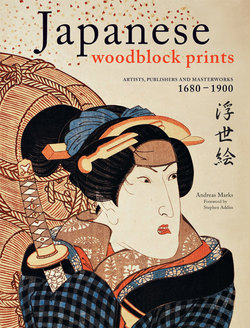Читать книгу Japanese Woodblock Prints - Andreas Marks - Страница 24
На сайте Литреса книга снята с продажи.
ОглавлениеHarunobu
1725?–1770
Family names: Hozumi, Suzuki. Given name: Jihei. Art names: Chōeiken, Shikojin.
Suzuki Harunobu is thought to have been born in 1725 and lived in Kanda Shirakabechō according to the “Wastepaper Basket” (Hōgu kago) from the 1800s, written by Morishima Chūryō (1756–1810). [According to the “Supplement to Ukiyo-e Miscellany” (Zoku ukiyo-e ruikō) he lived in Ryōgoku Yonezawachō, however this source is from 1833 and seems rather unreliable as Harunobu’s artist name is given as “Koryūsai.”] It is unclear who he received his artistic training from and how he started his career. He probably was a student of Nishimura Shigenaga but also shows the influence of Nishikawa Sukenobu in his female portraits. His earliest known designs are dated to 1760, when he was in his thirties. These prints are benizuri-e (two-color-printing) and mizue (water pictures). The figure at the bottom left of page 59, Ōtomo no Kuronushi, is from the rare narrow-format (hosoban) series “Six Saints of Poetry” (Rokkasen), issued around 1765 by Iwatoya Genpachi. In these mizu-e the key block is colored and not black, hence the very light appearance of the print.
During the first half of the 1760s, Harunobu designed several actor prints. The majority of them are rather unexciting and lack the vigor of the kabuki theater. To the second half of the 1760s date a few warrior prints by Harunobu. In 1765, the first, innovative “brocade pictures” (nishiki-e) which caused a shift towards full-color printing were produced, showing Harunobu’s designs. Amongst them are “pictorial calendars” (egoyomi) from the years 1765 and 1766, commissioned by groups of haikai poets. These picture calendars were printed in small numbers and exchanged at parties. They were the driving force to the further commercialization of the print market and Harunobu was the foremost designer of such prints. Deriving from such picture calendars is his celebrated series “Eight Views of the Parlor” (Zashiki hakkei), published c.1766. The figure on the right shows one of the eight designs, “Descending Geese of the Koto Bridges,” in the first state with signature and seal of the haikai poet Kikurensha Kyosen, in reality the shogunal retainer ōkubo Jinshirō Tadanobu (1722–1777), who commissioned this series from Harunobu.
When the boom of picture calendars ended, Harunobu turned his focus to “parody pictures” (mitate-e) on a rich variety of pictorial and literary subjects. The figure on the next page, “Parody of Narihira’s Journey to the East,” from c.1768-69 is an example of this type of print, as is the figure on the upper right of page 59 from around the same time, depicting the young girl Ofuji, a sales girl at the well-known toothpick shop Hon’yanagi, together with the fortune god Ebisu from the series “Modern Seven Gods of Good Fortune” (Tōsei shichifukujin). Until Harunobu’s death in 1770, his delicate and sensual beauties dominated the print market. His designs are predominantly in chūban (medium print) size and his entire output of single-sheet prints, some of them actors but mostly young men and girls from the Yoshiwara pleasure quarter, is close to 900. Harunobu also produced several erotic works, very few paintings, and illustrated some seventeen books.
c.1766 “Descending Geese of the Koto Bridges”, from the series “Eight Views of the Parlor” (Zashiki hakkei). Chūban. Asian Art Museum, National Museums in Berlin. Suzuki 1979, no. 512-4-1.
c.1768–69 Parody of Narihira’s journey to the east. Chūban. Asian Art Museum, National Museums in Berlin. Suzuki 1979, no. 379.
1760s The actor Ichimura Uzaemon IX as Osugi in an unidentified play. Hosoban benizuri-e. Publisher: Harimaya Shinshichi. Library of Congress. Suzuki 1979, no. 47; unlisted in Mutō 2005.
c.1768–69 Young girl in loose kimono, washing cloth in a stream under a willow tree. Chūban. Asian Art Museum, National Museums in Berlin. Suzuki 1979, no. 570?.
c.1768–69 Evening cool on a bench. Chūban. Collection Peter Rieder. Suzuki 1979, no. 433?.
c.1765 Parody of a smoking fortune god Hotei watching the moon in attendance of courtesans. Chūban. Asian Art Museum, National Museums in Berlin. Suzuki 1979, no. 182.
c.1765 “ōtomo no Kuronushi”, from the series “Six Immortal Poets” (Rokkasen). Hosoban mizu-e. Publisher: Iwatoya Genpachi. Collection Peter Rieder. Suzuki 1979, no. 26.
c.1768–69 Ofuji, a sales girl at the well-known toothpick shop Hon’yanagi, together with the fortune god Ebisu, from the series “Modern Seven Gods of Good Fortune” (Tōsei shichifukujin). Chūban. Collection Peter Rieder. Suzuki 1979, no. 306-1.
